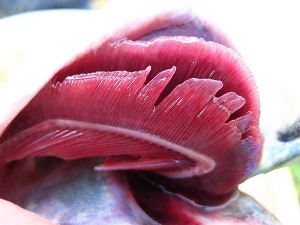
Gills as we all know is the respiratory organ that helps fish breathe. It is only due to gills, fish survive in water.
So gills are very important for fish but they are very fragile as well. I am saying fragile in the sense that they easily get attacked by parasites and bacteria.
This is especially true if you are housing your fish under poor living conditions.
Before I go any further regarding gills, let me inform you something about pet fish care.
Here lately, I have been getting a lot of questions from the readers of this website regarding why their fish are showing abnormal behaviors.
To find out what the problem is, I ask them some simple questions. And a lot of times, I find out the cause of the problems pretty quick!
My questions usually circulate around the environmental and feeding factors. Here is the list of some of the questions I ask:
- Do you over feed your fish out of love?
- Do you feel lazy changing the aquarium water on a regular basis?
- Do you forget to check the water filter frequently to see if it is in a proper working condition or not?
- Do you see too much debris in the aquarium?
- Do you see cloudy water in the tank?
- Are the fish mostly swimming close to the surface of the water?
- Are there too many fish stocked in the aquarium?
- Do you change all the water in the aquarium at one time?
Well, if you have answered ‘yes’ to any of the questions, you better alert yourself.
People usually commit some very common mistakes and risk losing their fish. Disasters can really be prevented if you take precautions and be a little extra vigilant.
Now after these handy tips on pet fish care, let us go back to talking about the gills.
Here are the 3 major causes of environmental gill disorders in fish and how to prevent them:
- Excessive carbon dioxide in the aquarium:
When the carbon dioxide level is above 20 mg per liter (0.264 US gallons) in the aquarium, it becomes a threat to the fish.
The water becomes acidic making the fish sick. When fish have to live under such circumstances, they become lethargic. You will be asking yourself why it seems like your fish are getting lazy (O:
Eventually your fish are going to die if this continues. So you need to remove the excess amount of carbon dioxide formed in the aquarium.
This is done by forceful aeration. Forceful aeration is the process of stirring up the water really good to blow out the excess carbon dioxide into the air and increase the water’s pH level.
If you already don’t have airstones installed, I recommend you doing so.
Airstones, also known as Aquarium bubbler, is porous aquarium furniture which is used to gradually diffuse air into the tank, oxygenating the water in the tank.
If you already have one installed, it might need some cleaning. Over time the pores tend to get clogged with mineral deposits and algae.
You can clean them up by boiling them in vinegar and water, scrubbing them, and forcing air back through them.
- Gas bubble disease:
If you got an aquarium and have gained knowledge about the possible diseases your fish might get, the gas bubble disease should not be an unfamiliar subject matter for you.
This disease takes place in aquarium with a cold water system. If your aquarium water has too many dissolved gases like carbon dioxide, nitrogen, argon, etc. fish develop the gas bubble disease.
This occurs when the water is heated up too quickly or because of a faulty pump. It can also occur if there is a heavy algal growth in ponds.
The symptom of this disease is clearly visible. The indication is small bubbles near or in the fins, gills and the eyes of the fish.
Treatment consists of blowing the harmful gases out from the tank. This is done through forceful aeration, the same process mentioned above.
Thankfully this disease isn’t contagious. However, the condition may become serious if attacked by bacteria. If the gills are severely attacked, there is nothing much you can do about it. Your fish will gradually die.

If you want to know more about gas bubble disease click here.
- Hydrogen sulfide toxicity:
You know, there is a lot of chemical reaction that goes on in a fish tank. Some of them are crucial for your fish’s health where as some are deadly if they occur.
The formation of hydrogen sulfide aka H2S is one such chemical reaction. H2S gas emits a very strong and a toxic smell, pretty much like the rotten eggs.
This harmful gas forms in the aquarium/tanks or ponds when organic debris like vegetation and fish food gets accumulated and certain bacteria feed on it.
Fish that are exposed to H2S for an extensive period of time look sick and thin. And they also develop irreversible gill damage.
There is only one treatment that could be done for this toxicity. It is done by adding fresh water in the aquarium.
My suggestion for you is to understand that prevention is always better than cure.
![]() Aerating the water really good at all times, making sure the filter is working properly, cleaning the tank regularly, not overfeeding the fish are some of the things you can do to greatly reduce the chances of having H2S toxicity in your fish’s habitat.
Aerating the water really good at all times, making sure the filter is working properly, cleaning the tank regularly, not overfeeding the fish are some of the things you can do to greatly reduce the chances of having H2S toxicity in your fish’s habitat.
More on preventing the gill disorders:
If you do not have a pH test kit yet, I recommend you get one from your local pet (fish) store. Only a test kit will help you to determine the right pH level needed for your fish.
Many freshwater fish flourish in a broad pH range between slightly acidic (6.5) to slightly alkalic (7.5). Some sensitive fish however, require special water conditions.
To provide their ideal water conditions, you need to make adjustments to your aquarium water using pH conditioners. Furthermore, to prevent these environmental gill disorders you need to regularly test the water for pH and gas levels.
Last but not least, keep the diseased fish isolated in a different tank to avoid any infection to spread and most important of all, keep the habitat clean at all times.
Do you find this article helpful? Please don’t hesitate to comment below. We would love to hear your thoughts and experiences.
Share this article in your favorite social media outlets:






